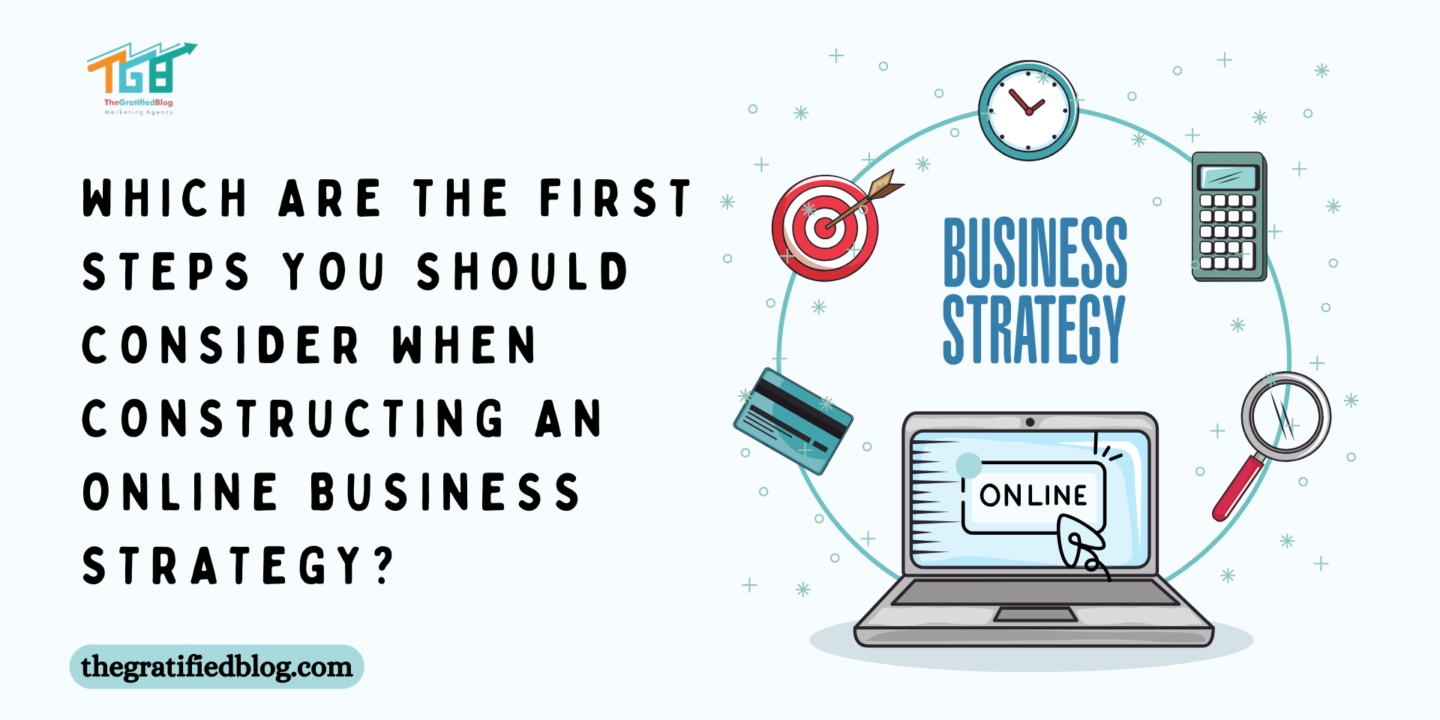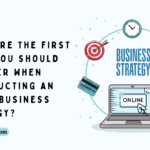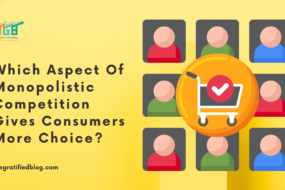
Setting up an online business is full of excitement, but it also requires careful planning. If you do not have a strategy in place, you might struggle to grow or even get started. Whether you are launching an e-commerce store, a digital service, or an online platform, the right approach can make all the difference.
Which are the first steps you should consider when constructing an online business strategy? This blog walks you through the key initial steps to building a solid online business strategy. Each step is practical, straightforward, and easy to follow.
What Is an Online Business Strategy?
An online business strategy is a structured plan that outlines how a company operates, markets, and grows in the digital space. It defines the business’s goals, target audience, revenue models, marketing channels, and competitive positioning to achieve long-term success.
Key Components of an Online Business Strategy
- Business Model Selection – Choosing the right online business model, such as e-commerce, SaaS, affiliate marketing, or subscription-based services.
- Target Audience Identification – Defining the ideal customers, their demographics, preferences, and behaviors.
- Value Proposition – Clearly stating what makes the business unique and how it solves customers’ pain points.
- Website & Digital Presence – Developing a professional website, optimizing it for conversions, and ensuring a seamless user experience.
- Marketing Strategy – Utilizing digital marketing channels like SEO, PPC, social media, email marketing, and content marketing to attract and retain customers.
- Sales & Revenue Generation – Setting up online purchase funnels, pricing strategies, and monetization methods.
- Customer Engagement & Retention – Implementing customer support, loyalty programs, and personalized interactions to build strong relationships.
- Technology & Tools – Leveraging automation, analytics, and AI to improve operations and decision-making.
- Competitive Analysis – Researching competitors and positioning the business effectively in the market.
- Scalability & Growth – Planning for expansion, partnerships, and scaling operations to maximize profitability.
A well-crafted online business strategy helps businesses establish a strong digital presence, generate revenue, and sustain long-term success in a competitive landscape.
Why Having an Online Business Strategy Matters?
Many people jump into online business without a plan. They set up a website, post on social media, and hope for the best. But without a strategy, success becomes a game of luck.
A well-planned strategy helps you:
- Make clear decisions – Know where to focus your time, money, and energy.
- Reach the right customers – Understand who your audience is and how to attract them.
- Stand out from competitors – Find ways to offer something unique in your industry.
- Manage risks – Avoid common mistakes that lead to business failure.
- Measure success – Track progress and adjust plans when needed.
Having a strategy saves time and money. Instead of guessing what works, you create a structured plan to grow your business step by step.
Which Are the First Steps You Should Consider When Constructing an Online Business Strategy?
The first step in building an online business strategy is to clearly define your business idea, whether it’s selling products, providing services, or producing digital content.
Here are the steps you should consider in creating an online business strategy:
1. Define Your Business Idea
Every online business starts with an idea. It could be selling products, offering services, or creating digital content. But before you dive in, you need to make sure your idea is worth pursuing.
How to validate your idea:
- Solve a real problem – The best business ideas help people in some way.
- Check demand – Use tools like Google Trends or keyword research to see if people are looking for what you offer.
- Analyze competitors – If others are doing something similar, study their strengths and weaknesses.
- Ask potential customers – Get feedback from friends, family, or online communities.
2. Identify Your Target Audience
Not everyone will be interested in what you sell. You need to figure out who your ideal customers are.
Questions to ask:
- Who will benefit most from your product or service?
- What problems do they face?
- Where do they spend time online?
- What are their interests, age group, and buying habits?
Once you understand your audience, it becomes easier to market your business effectively.
3. Research the Market
Before you launch, take time to research the industry you are entering. This helps you avoid common mistakes and spot opportunities.
Key areas to focus on:
- Trends – What is changing in your industry?
- Competition – What are others doing well, and what can you do better?
- Pricing – How much are customers willing to pay for similar products or services?
Market research gives you insights that shape your strategy.
4. Choose a Business Model
An online business can operate in different ways. Choosing the right business model depends on what you offer.
Common business models:
- E-commerce – Selling physical or digital products through an online store.
- Subscription services – Offering ongoing access to products or content for a monthly fee.
- Freelancing – Providing skills like writing, design, or marketing.
- Affiliate marketing – Earning commissions by promoting other businesses.
- Dropshipping – Selling products without handling inventory.
Pick a model that aligns with your skills, budget, and long-term goals.
5. Create a Business Name and Brand Identity
A strong brand helps you stand out. Your business name, logo, and design elements shape how people see you.
Tips for branding:
- Choose a name that is simple, unique, and easy to remember.
- Design a logo that reflects your business identity.
- Pick brand colors and fonts that are consistent across your website and marketing.
- Write a clear mission statement that explains what you do and why.
Good branding builds trust and attracts customers.
6. Register Your Business and Set Up Legal Aspects
Even an online business needs to be legally compliant. It is important to handle this early to avoid problems later.
Steps to take:
- Choose a business structure (sole proprietorship, LLC, etc.).
- Register your business name if required.
- Check tax requirements for your location.
- Get any necessary licenses or permits.
Handling these legal details now saves you from headaches later.
7. Build a Website or Online Store
Your website is the foundation of your online business. It needs to be user-friendly, professional, and optimized for sales.
Key elements of a good website:
- A clean and simple design.
- Easy navigation.
- Clear product or service descriptions.
- A secure and simple checkout process.
- Mobile-friendly layout.
You can use platforms like Shopify, WordPress, or Wix to build your website without coding.
8. Set Up Payment Methods
If you are selling online, you need a reliable way to collect payments.
Popular options:
- PayPal – Easy to set up and widely used.
- Stripe – Great for credit card processing.
- Shopify Payments – If using Shopify.
- Bank transfers – Some customers prefer this method.
Make sure payments are secure to protect customer data.
9. Develop a Marketing Strategy
Having a great product or service is not enough. You need to promote it.
Marketing strategies to consider:
- Social media marketing – Use platforms like Instagram, Facebook, and LinkedIn to connect with your audience.
- SEO (Search Engine Optimization) – Optimize your website so people can find you on Google.
- Email marketing – Send updates and offers to your customers.
- Content marketing – Create blog posts, videos, or guides to attract visitors.
- Paid ads – Use Google Ads or Facebook Ads to reach more people.
A strong marketing plan helps you gain visibility and attract customers.
10. Set Business Goals and Track Progress
Goals keep you focused and help you measure success. Without clear objectives, you might not know if your business is growing.
How to set goals:
- Use the SMART method (Specific, Measurable, Achievable, Relevant, Time-bound).
- Track sales, website traffic, and customer engagement.
- Adjust your strategy based on results.
Monitoring progress helps you make better decisions.
11. Build Customer Relationships
Customers are the heart of your business. Happy customers come back and bring referrals.
Ways to build strong relationships:
- Offer excellent customer service.
- Respond quickly to messages and concerns.
- Personalize interactions where possible.
- Create a loyalty program or offer discounts to repeat buyers.
The better you treat customers, the more likely they are to support your business.
12. Keep Improving and Adapting
The online world changes fast. Your business needs to evolve with trends, technology, and customer preferences.
How to stay ahead:
- Keep learning about your industry.
- Test new marketing strategies.
- Listen to customer feedback.
- Update your website and offerings regularly.
Successful businesses keep growing by staying flexible and open to change.
Conclusion
Starting an online business is exciting but requires careful planning. By following these steps, you can build a strong foundation for success.
To recap:
- Define your business idea.
- Identify your target audience.
- Research the market.
- Choose a business model.
- Create a brand identity.
- Register your business and handle legal matters.
- Build a professional website.
- Set up payment methods.
- Develop a solid marketing strategy.
- Set goals and track progress.
- Focus on customer relationships.
- Keep improving and adapting.
Each step brings you closer to building a successful online business. Start small, stay consistent, and keep learning along the way.
Frequently Asked Questions
Q1. Which are the first steps you should consider when constructing an online business strategy?
Ans. The first step in creating an online business strategy is to define your business idea. Clearly identify your niche, target audience, and unique value proposition. Understand what problem you are solving and how your product or service stands out. A well-defined idea sets the foundation for success.
Q2. Why is an online business strategy important?
Ans. An online business strategy helps define clear objectives, target the right audience, and build a structured plan for growth. It ensures your business operates efficiently, remains competitive, and maximizes digital opportunities.
Q3. How do I identify my target audience?
Ans. Conduct market research to understand your ideal customers. Analyze demographics, interests, behaviors, and pain points. Tools like Google Analytics, social media insights, and customer surveys can help refine your audience.
Q4. How do I choose the right business model?
Ans. Select a model that aligns with your goals and market demand. Common models include e-commerce, subscription services, SaaS, affiliate marketing, and digital products. Research competitors and industry trends to make an informed decision.
Q5. What role does branding play in an online business strategy?
Ans. Branding creates a strong identity that resonates with customers. A compelling brand includes a unique logo, consistent messaging, a well-defined value proposition, and a professional website that reflects your business personality.
Q6. How important is website development in an online strategy?
Ans. A website serves as your digital storefront. Ensure it is user-friendly, mobile-responsive, fast-loading, and SEO-optimized. Platforms like WordPress, Shopify, or Wix can help build a professional website with minimal technical expertise.
Q7. What digital marketing strategies should I implement first?
Ans. Start with a mix of organic and paid strategies, such as:
- SEO: Optimize content to rank higher on search engines.
- Content Marketing: Create valuable blog posts, videos, and guides.
- Social Media Marketing: Engage with audiences on platforms like Facebook, Instagram, and LinkedIn.
- Email Marketing: Build a list and nurture leads with targeted campaigns.
- Paid Ads: Use Google Ads or social media ads to drive traffic.
Q8. What role does customer experience play in an online business strategy?
Ans. Providing excellent customer experience builds trust and loyalty. Ensure easy navigation, fast customer support, seamless checkout, and personalized interactions to enhance satisfaction.








No Comments